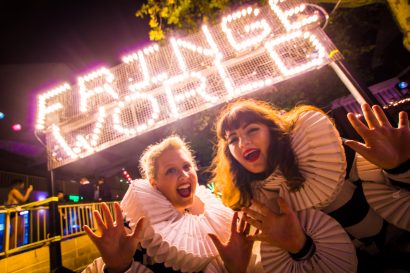Tourism and the arts are both finding their feet post-pandemic. How can the relationship between the two be strengthened now and into the future? Julie Hosking reports in the final of a three-part series in partnership with the Chamber of Arts and Culture WA.
Let’s talk about the future: Making the tourism dream a reality
17 October 2022
- Reading time • 10 minutesMulti-arts
More like this
- Halloween special: How to make blood and other stage tricks
- Seadragon weaves magic spell
- Spring into the school holidays
As the camera pans across rugged ochre ranges to lush forests, turquoise seas and blinding white sands, two dancers twist and turn through the ever-changing landscape.
Gums bend magically with the dancers’ fluid movements; grapes float like giant bubbles above them as they run through vineyards; an enormous whale glitters overhead as they stand waist-deep in the ocean.
This is Tourism Western Australia’s latest campaign, Walking on a Dream, where the surreal meets the sublime.
That our State is awash with astounding natural beauty is hardly news – it’s what we’ve been selling to the world forever. But this push for tourist dollars also puts local creatives front and centre, in the campaign’s imagination and execution and in the State Government’s plans for our future.
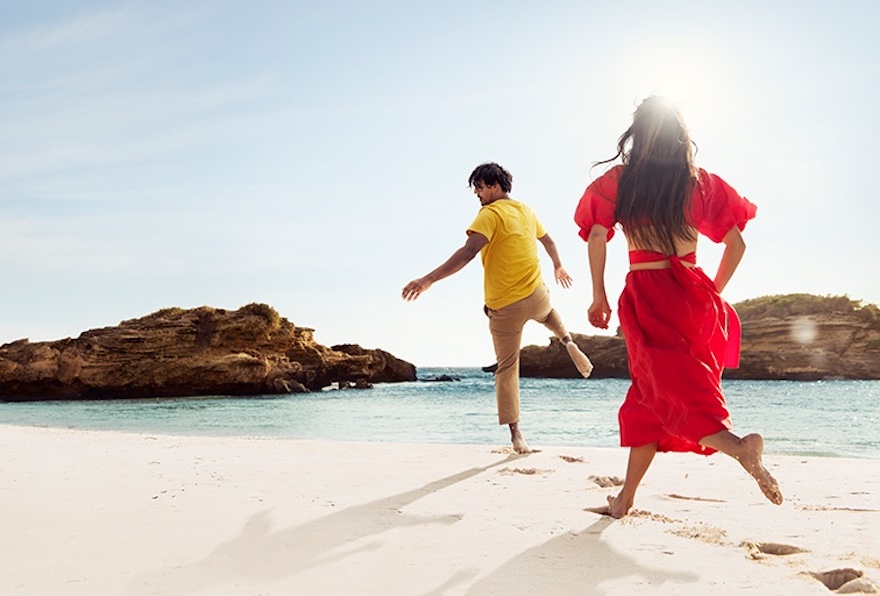
First Nations dancers Rika Hamaguchi and Ian Wilkes are the faces of the $15 million global sales pitch, lithely moving through our awe-inspiring outdoors to an ethereal rendition of Empire of the Sun’s song “Walking on a Dream”. The duo’s West Australian co-founder Luke Steele was commissioned to rework the 2008 hit, and the videos were conceived and directed by Perth-based creatives The Brand Agency and shot by a local crew.
Tourism Western Australia Board Chair Di Bain say the campaign is part of a concerted effort by the State Government authority to build capacity in the arts and cultural sector. This includes collaborating with the Arts and Culture Trust, which recently replaced the Perth Theatre Trust with an expanded remit, to elevate local talent.

“It’s absolutely a number one item on our agenda for 2023, to develop homegrown events which employ Western Australians in the arts sector and give them year-round work,” Bain says.
“If someone comes here for a sporting event or convention and there’s an arts and culture event … that’s just uniquely Western Australia that we are doing, they will stay longer and they will take more time out to experience that. That’s the holy grail of tourism; you want people to come but you want them to stay and spend.”
Mark Howett, the Director of Place Management at the Arts and Culture Trust, is excited about what the campaign represents.
“The thing that really struck me was it’s our voice – it’s not strategy that comes from what other people think Western Australians should be like. It’s from Western Australia,” he says.
Sharing our unique culture
A founding member of the Bangarra Dance Company and later artistic director of Ochre Contemporary Dance Company, the proud Noongar man knows the power of authentic storytelling.
“Of all the touring that I did around the world, the shows that really resonated not only with me but with audiences in general were when we told Western Australian stories like Cloudstreet,” he says.
“It’s showing our unique culture in all its manifestations that people will want to engage with. And that includes the conversation we have with each other, and with them when they come onto Boodjar, onto Country.”
Helen Curtis, the founder and director of creative consultancy Apparatus, is equally impressed with the campaign’s marriage of art and tourism.
“This feels like a moment where we understand we don’t need to look to anywhere else for excellence – it’s all here,” she says.
“When people come here, they’re not being promised sports events. They’re being promised arts and culture. So now I think we have to deliver on that promise. What we need to start talking about in the arts community is what’s the offering to all the people who come here and how can we expand on the stories that we’re telling.”

Stories such as Boorna Waanginy (The Trees Speak), which led visitors through an illuminated Kings Park in a magical immersion of sights and sounds for the 2017 Perth International Arts Festival (now Perth Festival). Both a celebration of the six Noongar seasons and a powerful message about climate change, the homegrown event was so popular it made a triumphant return in 2019, drawing more than 200,000 visitors.
Howett was the lighting designer for the project, which he describes as an interface between art, Boodjar and science. The more that we collaborate, he maintains, the more we bring in different elements and ensure a better future for all.
“And it reinforces that art is also good for our wellbeing – tourists want to engage with something that makes them feel good,” he says.
“I think that Boorna Waanginy really brought all of those elements together and engaged so many Western Australians who walked through that on our beautiful summer balmy evenings in an arts event that probably had a multi-generational effect.”
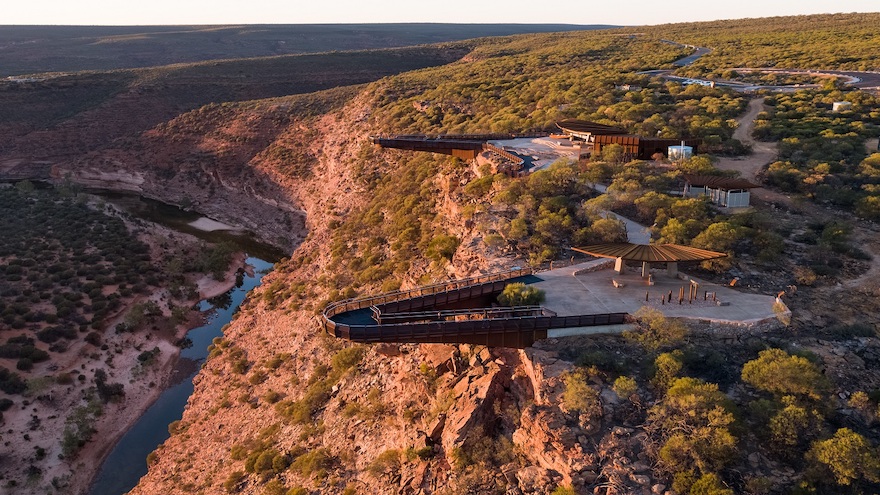
Curtis, whose consultancy specialises in integrating art and interpretive design into built form, also sees opportunities for a confluence of tourism and culture to make long-lasting impressions in regional areas, citing the success of the Kalbarri Skywalk (Kaju Yatka) as an example.
Purpose-built platforms snake out over the Murchison River gorge, providing stunning views, with a café and other amenities that tourists appreciate, even in the wilderness. Crucially, the local Nanda people were heavily involved in the project, creating interpretative artwork and sharing their history.
“So that story is really front and centre at Kalbarri Skywalk and all of the stats and research are now showing that it has brought in massive tourism,” Curtis says.

This kind of storytelling could be incorporated to make the most of other quintessentially West Australian sites, such as Walganna (also known as Walga Rock) and Wilgie Mia in the State’s north-east.
“Walganna is the second biggest monolith in Western Australia and Walganna has amazing rock art,” Curtis says.
“Not far away is Wilgie Mia, which is the oldest human mine in the whole of the planet (where) red ochre was mined for thousands of years.”
Bain, who is also Perth Deputy Lord Mayor, says there is “an absolute willingness and desire” to ensure good outcomes for arts and culture in Western Australia, from the Premier Mark McGowan down.
“It’s the bit that’s missing from our suite of activity over the calendar year,” she says.
Investing in the cultural experience
One challenge is getting tourists here and around our vast State; the other is ensuring that once they arrive their experience is memorable for all the right reasons.
“We need more accommodation in various parts of Western Australia, and we need more investment in infrastructure and those built-form attractions for sure,” Bain says.
“But we also need investment in the experience that they’re going to have in terms of learning about our culture and who we are and being exposed to that in the arts scene.”
With the growing reputation of the Perth Festival, which celebrates its 70th birthday next year, has come a global distribution list, one that Bain believes could also prove invaluable in attracting international travellers.
Tourism WA works closely with agents who build packages for sporting events, such as the ICC World Cup or the recent sellout football match between the Premier League’s Manchester United and Aston Villa at Optus Stadium. It’s not common practice in the arts sector.
“It’s just trying to get that sort of tourism trade sophistication into some of our larger organisations that have globally recognised talent, whether it be WASO, Co3, the WA Ballet, Opera,” Bain says. “What international travel operators want are commissions – they will bring people here if they can get a commission from a ticket sale.”
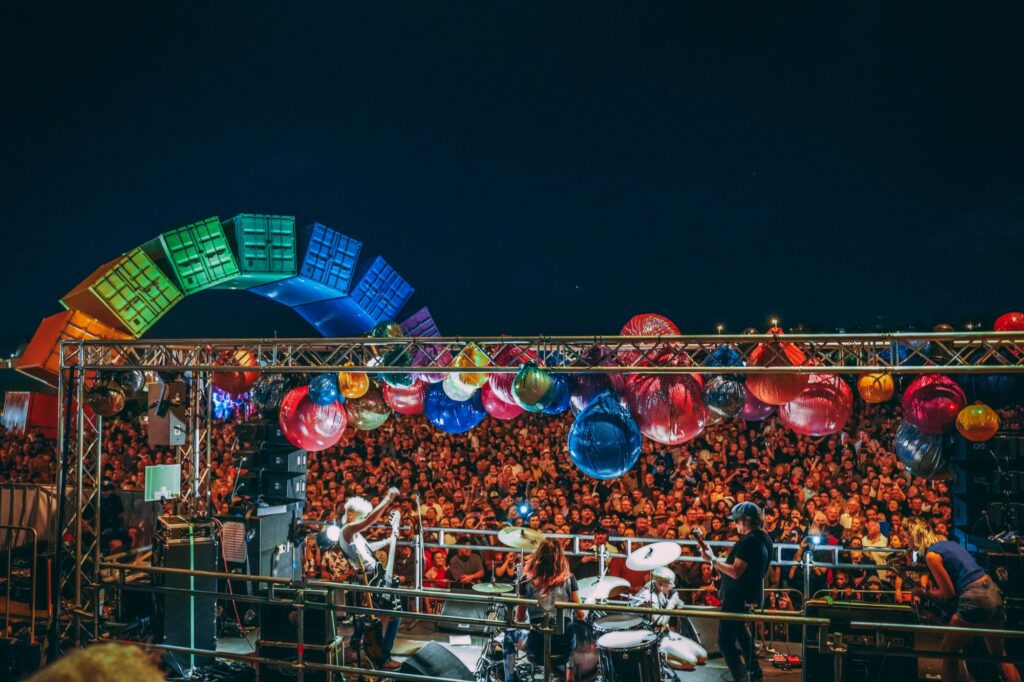
This means creating cultural attractions and events that generate a buzz here and overseas. Events such as Highway to Hell, the all-day music fest that closed 10km of Canning Highway for the world’s longest stage, drew more than 144,000 people and added millions to the State’s economy. Marking the 40th anniversary of the burial of Freo boy and AC/DC legend Bon Scott, the 2020 Perth Festival finale was also named the best cultural, arts or music event in Australia.
Research shows that we have barely scratched the surface, however, of one of our biggest global drawcards. More than two-thirds of international tourists who come to WA want an Aboriginal cultural experience, but only 20 percent leave having had one.
Launching Walking on a Dream at WA Museum Boola Bardip early last month, Tourism Minister Roger Cook described Aboriginal culture as “the beating heart of WA’s tourism strategy”.
Minister Cook said Western Australia needed to be bold and different to compete for the tourist dollar, but “above all we need to have a strong sense of identity”.
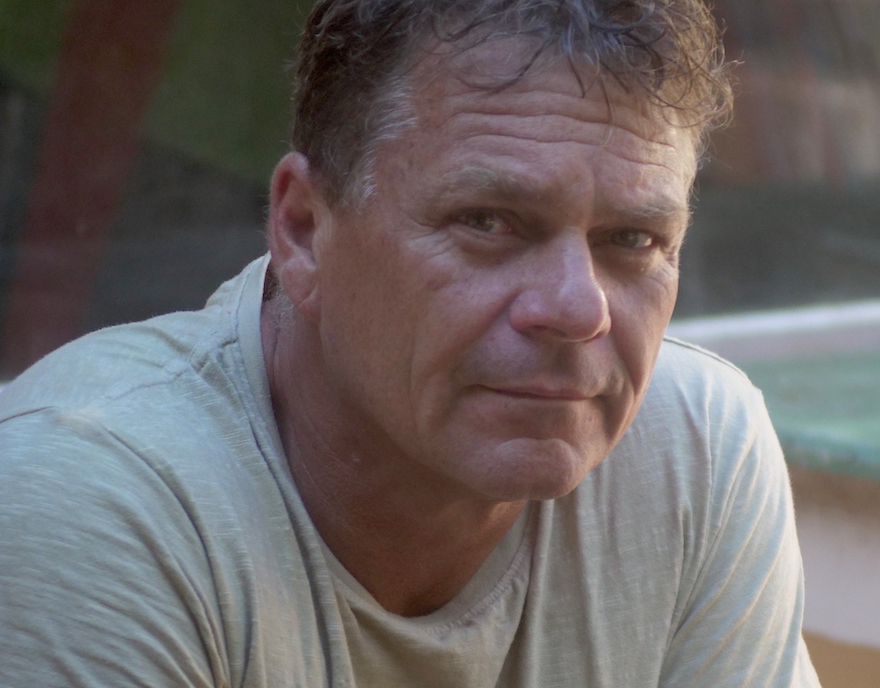
One of the biggest opportunities to strengthen that sense of identity is just over the horizon – the 200th anniversary of settlement of the Swan River Colony, in 2029.
“I’ve been speaking with elders from down south about some of the possibilities and they’re only the beginning. It is a conversation and an understanding together that leads to meaningful projects of worth,” Howett says, acknowledging such a sensitive occasion will not be without its challenges.
“It’s got to relate back to truth telling and all of the history in all its complexity so that people can express their grief, can express their wishes for improvement and to make things better.”
The State and Federal Governments recently pledged $104 million to build a world-class Aboriginal cultural centre between the Swan River and Perth Concert Hall by 2028.
Even our capital’s identity can be enhanced by embedding Aboriginal culture not just in buildings but in how we present the city to the world. Curtis points out there are 17 “Perths” dotted around the world, including one in Tasmania: “But here’s the cracker – there’s only one Boorloo.”
Supporting arts with multi-year funding
While we cannot stake our place on the world’s cultural stage without significant investment, the way that money is allocated is also important.
Last November the State Government, through Lotterywest, committed $3.6 million to Fringe World over the next three years.
“The City of Perth actually just at our last council meeting agreed to fund Fringe, I think, $1.2 million over three years,” Bain says.
“Tourism Western Australia has been quite good at giving multi-year funding agreements, but the City of Perth is going to start looking at that as well.”
Multi-year funding not only gives security to arts organisations but enables them to concentrate on what they do best – being creative.
“By the time you’ve pulled your event off, then you have to go back and sit down and audit your accounts and invest so heavily every year in doing that,” Bain says.
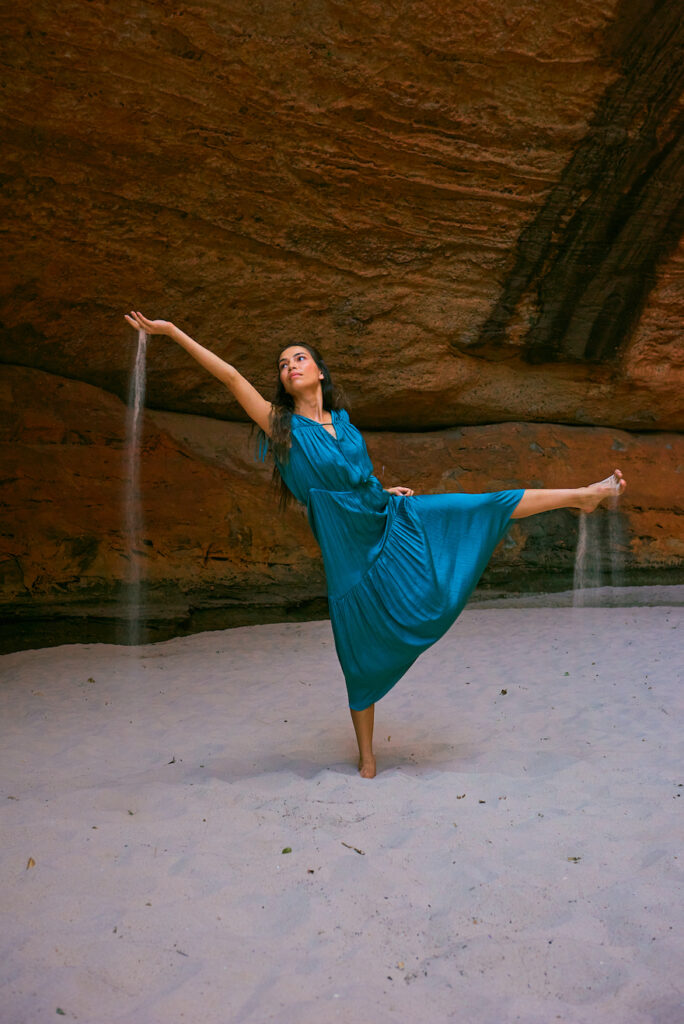
Aside from capital for built-form tourism offerings such as the Kalbarri Skywalk, Curtis believes government should invest more in the grassroots arts organisations that develop local talent.
“That’s how you get the Boorna Waanginys, cause that’s all homegrown talent,” she says. “So investing in young people and emerging talent now so that in five, 10, 15 years, they’re going to be ready to do the next big thing. What Di is talking about with those packages sounds really exciting – they’ll pay off in five years’ time – but we need to have something for those guys to sell.”
Having pushed for a biennial or triennial when she was at the City of Perth 20 years ago, Curtis still dreams of a visual arts festival on the scale of the recent Sydney Contemporary.
“It would be great to have something like that in Perth, similar to the craft triennial (IOTA). To have a visual arts festival that’s actually for the public so that it involves all the art galleries … that would be a really massive thing.”
Howett would like Western Australia to embrace cultural exchanges and larger scale events, building local capacity and promoting pride in showing the world who we are and what we can do.
If our artists, dreamers and thinkers can create cultural experiences that make visitors truly feel – not just see – the magic of our “magnificent Boodjar” wherever they venture, that’s a journey worth every step. One that started thousands of years ago.
“It’s such an incredible country and knowing that all the Aboriginal cultures have such a strong connection to Country,” Howett says. “If we allow Aboriginal people to have the power to exchange those stories in a way that they would like to do it, then we’ve got this unique opportunity that cannot be replicated anywhere in the world. And I think that’s really exciting.”
To paraphrase Steele’s lyric wafting over images of dreamy WA: “We’re just in awe of what’s in front of us.”
Read more from the series with part one: “Let’s talk about the future: Can the arts help save the planet” and part two: “Let’s talk about the future: better health and wellbeing”
This article was produced in partnership with the Chamber of Arts and Culture WA with support from Lotterywest.
Pictured top: The Walking on a Dream campaign melds art and nature. Image: Tourism Western Australia
Like what you're reading? Support Seesaw.



